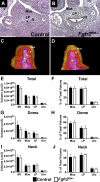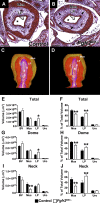Fgfr2 is integral for bladder mesenchyme patterning and function
- PMID: 28052872
- PMCID: PMC5407073
- DOI: 10.1152/ajprenal.00463.2016
Fgfr2 is integral for bladder mesenchyme patterning and function
Abstract
While urothelial signals, including sonic hedgehog (Shh), drive bladder mesenchyme differentiation, it is unclear which pathways within the mesenchyme are critical for its development. Studies have shown that fibroblast growth factor receptor 2 (Fgfr2) is necessary for kidney and ureter mesenchymal development. Our objective was to determine the role of Fgfr2 in bladder mesenchyme. We used Tbx18cre mice to delete Fgfr2 in bladder mesenchyme (Fgfr2BM-/-). We performed three-dimensional reconstructions, quantitative real-time PCR, in situ hybridization, immunolabeling, ELISAs, immunoblotting, void stain on paper, ex vivo bladder sheet assays, and in vivo decerebrated cystometry. Compared with controls, embryonic (E) day 16.5 (E16.5) Fgfr2BM-/- bladders have thin muscle layers with reduced α-smooth muscle actin levels and thickened lamina propria with increased collagen expression that intrudes into muscle. From postnatal (P) day 1 (P1) to P30, Fgfr2BM-/- bladders demonstrate progressive muscle loss and increased collagen expression. Postnatal Fgfr2BM-/- bladder sheets exhibit decreased contractility and increased passive stretch tension compared with controls. In vivo cystometry revealed high baseline and threshold pressures and shortened intercontractile intervals in Fgfr2BM-/- bladders compared with controls. Mechanistically, while Shh expression appears normal, mRNA and protein readouts of hedgehog activity are increased in E16.5 Fgfr2BM-/- bladders compared with controls. Moreover, E16.5Fgfr2BM-/- bladders exhibit higher levels of Cdo and Boc, hedgehog coreceptors that enhance sensitivity to Shh, than controls. Fgfr2 is critical for bladder mesenchyme patterning by virtue of its role in modulation of hedgehog signaling.
Keywords: bladder development; bladder dysfunction; fibroblast growth factor receptor 2.
Copyright © 2017 the American Physiological Society.
Figures












Similar articles
-
Fgfr2 is integral for bladder mesenchyme patterning and function.Am J Physiol Renal Physiol. 2015 Apr 15;308(8):F888-98. doi: 10.1152/ajprenal.00624.2014. Epub 2015 Feb 4. Am J Physiol Renal Physiol. 2015. Retraction in: Am J Physiol Renal Physiol. 2016 Jul 1;311(1):F239. doi: 10.1152/ajprenal.zh2-7964-retr.2016. PMID: 25656370 Free PMC article. Retracted.
-
Analysis of the Sonic Hedgehog signaling pathway in normal and abnormal bladder development.PLoS One. 2013;8(1):e53675. doi: 10.1371/journal.pone.0053675. Epub 2013 Jan 7. PLoS One. 2013. PMID: 23308271 Free PMC article.
-
Urothelial sonic hedgehog signaling plays an important role in bladder smooth muscle formation.Differentiation. 2007 Dec;75(10):968-77. doi: 10.1111/j.1432-0436.2007.00187.x. Epub 2007 May 9. Differentiation. 2007. PMID: 17490411
-
Smooth muscle differentiation and patterning in the urinary bladder.Differentiation. 2010 Sep-Oct;80(2-3):106-17. doi: 10.1016/j.diff.2010.05.004. Epub 2010 Jun 12. Differentiation. 2010. PMID: 20541860 Free PMC article. Review.
-
Hedgehog signalling in development of the secondary palate.Front Oral Biol. 2012;16:52-9. doi: 10.1159/000337543. Epub 2012 Jun 25. Front Oral Biol. 2012. PMID: 22759669 Review.
Cited by
-
New developments in the biology of fibroblast growth factors.WIREs Mech Dis. 2022 Jul;14(4):e1549. doi: 10.1002/wsbm.1549. Epub 2022 Feb 9. WIREs Mech Dis. 2022. PMID: 35142107 Free PMC article. Review.
-
LIM homeodomain transcription factor Isl1 affects urethral epithelium differentiation and apoptosis via Shh.Cell Death Dis. 2019 Sep 26;10(10):713. doi: 10.1038/s41419-019-1952-z. Cell Death Dis. 2019. PMID: 31558700 Free PMC article.
-
Loss of Fibroblast Growth Factor Receptor 2 (FGFR2) Leads to Defective Bladder Urothelial Regeneration after Cyclophosphamide Injury.Am J Pathol. 2021 Apr;191(4):631-651. doi: 10.1016/j.ajpath.2020.12.011. Epub 2020 Dec 30. Am J Pathol. 2021. PMID: 33385344 Free PMC article.
-
Single-cell and spatial analysis reveal interaction of FAP+ fibroblasts and SPP1+ macrophages in colorectal cancer.Nat Commun. 2022 Apr 1;13(1):1742. doi: 10.1038/s41467-022-29366-6. Nat Commun. 2022. PMID: 35365629 Free PMC article.
-
Non-invasive voiding assessment in conscious mice.Bladder (San Franc). 2018 Apr 2;5(2):e33. doi: 10.14440/bladder.2018.582. eCollection 2018. Bladder (San Franc). 2018. PMID: 32775475 Free PMC article.
References
Publication types
MeSH terms
Substances
Grants and funding
LinkOut - more resources
Full Text Sources
Other Literature Sources
Molecular Biology Databases
Miscellaneous

